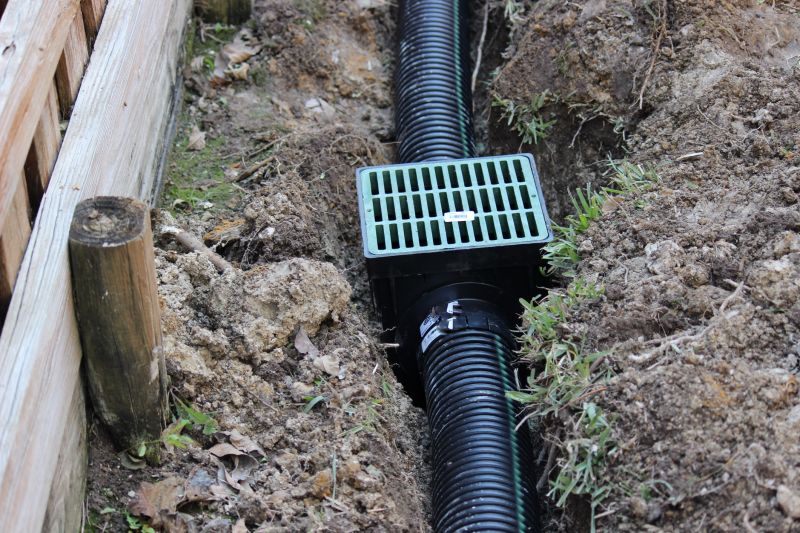Ultimate Product Selection for Porch Drainage System Upgrades
Equip your porch with premium drainage solutions that enhance functionality and prevent water pooling issues.
 Effective porch drainage is essential for maintaining a safe and functional outdoor space. Proper drainage helps prevent water accumulation, which can lead to structural damage, wood rot, and slippery surfaces. When selecting products for porch drainage installations, it is important to consider the specific needs of your porch, including size, slope, and existing landscape features. A well-designed drainage system not only enhances the longevity of your porch but also contributes to overall property safety and aesthetics.
Effective porch drainage is essential for maintaining a safe and functional outdoor space. Proper drainage helps prevent water accumulation, which can lead to structural damage, wood rot, and slippery surfaces. When selecting products for porch drainage installations, it is important to consider the specific needs of your porch, including size, slope, and existing landscape features. A well-designed drainage system not only enhances the longevity of your porch but also contributes to overall property safety and aesthetics.
Top Overall Option
Flexible Drainage Pipe System
A versatile and adaptable solution, flexible drainage pipes are suitable for various porch configurations. They can be easily routed around obstacles and conform to different landscape contours, making them a popular choice for DIY installations. Constructed from durable materials, these pipes resist corrosion and can handle significant water flow, helping to direct runoff away from the porch efficiently.
Types of Products For Porch Drainage Installations
Surface Drain Grates
Designed to sit flush with the porch surface, these grates allow water to flow into underground drainage systems while providing a sturdy walking surface.
Catch Basins
These large, open-top containers collect runoff from the porch area and direct it into underground piping or drainage channels.
Perforated Drainage Pipe
Perforated pipes facilitate underground water collection and diversion, ideal for trench systems along the porch perimeter.
Channel Drain Systems
Long, narrow drains that run across the porch surface to quickly channel water away from critical areas.
Gravel-filled Trench Drains
A trench filled with gravel combined with a drainage pipe offers a cost-effective solution for managing large volumes of water.
Flexible Corrugated Pipes
These pipes are easy to install and adapt to various landscape shapes, making them suitable for complex drainage layouts.
Water Diverter Flanges
Attach to downspouts to redirect water away from the porch area and prevent pooling.
Slope Adjustment Kits
Components that help modify the slope of drainage systems to ensure proper water flow toward outlets.
Drainage Outlet Fittings
Connect underground pipes to existing drainage systems or outlets, facilitating seamless water diversion.
Drainage End Caps
Seal the ends of underground pipes to prevent debris from entering and clogging the system.
Rainwater Diverters
Devices installed at gutters or downspouts to direct water away from porch surfaces.
Drainage Mesh Covers
Protect drains from debris while allowing water to pass through efficiently.
Slope Stabilizers
Ensure proper incline of drainage channels and pipes, maintaining effective water flow.
Flexible Sealant and Connectors
Seal joints and connections in drainage systems to prevent leaks and ensure durability.
Popular Choices
Widely used for their ease of installation and ability to handle surface runoff effectively.
Commonly installed at low points to gather water and prevent pooling on porches.
A popular underground option for directing water away from the porch foundation.
Ideal for high-traffic porch areas needing quick water removal.
Cost-effective and easy to install, suitable for managing larger volumes of water.
Popular for their adaptability in complex drainage layouts and ease of installation.
Effective for redirecting water from gutters and downspouts away from the porch.
Commonly used to prevent debris entry into drainage systems while maintaining flow.
Essential for sealing and connecting underground drainage pipes efficiently.
Popular for ensuring correct incline in drainage systems for optimal water flow.
There are various products available to manage water runoff effectively. From surface drains and catch basins to flexible piping and gravel-filled trench systems, each option offers different advantages depending on the installation context. For example, surface drains are suitable for areas with high water flow, while underground piping may be better for discreet, long-term solutions. Proper installation and the right choice of components are key to ensuring that water is directed away from your porch efficiently.
In addition to functional considerations, durability and ease of maintenance are important factors. Materials resistant to corrosion and weathering tend to perform better over time, reducing the need for frequent repairs. Many systems are designed for straightforward installation, making DIY projects feasible for homeowners with basic skills. Consulting with a drainage specialist can help identify the most appropriate products and configurations for your specific porch setup, ensuring effective water management for years to come.
Key Buying Considerations
- Assess the volume of water runoff to determine appropriate system capacity.
- Consider the porch size and slope to select compatible drainage solutions.
- Choose durable materials resistant to weathering and corrosion for longevity.
- Evaluate ease of installation, especially if opting for a DIY project.
- Determine whether surface or underground drainage best suits your needs.
- Ensure compatibility of fittings and connectors within the drainage system.
- Plan for proper outlet placement to direct water away from foundations and walkways.
- Account for local building codes and regulations related to drainage systems.
- Consider maintenance requirements and accessibility for cleaning or repairs.
- Select components that can accommodate future landscape changes or expansions.
- Evaluate the aesthetic impact of the drainage system on your porch design.
- Check for availability of replacement parts and system expandability.
- Consider if additional features like debris filters or diverters are necessary.
- Estimate overall project costs, including materials and potential professional assistance.
- Prioritize systems with clear installation instructions or support resources.
